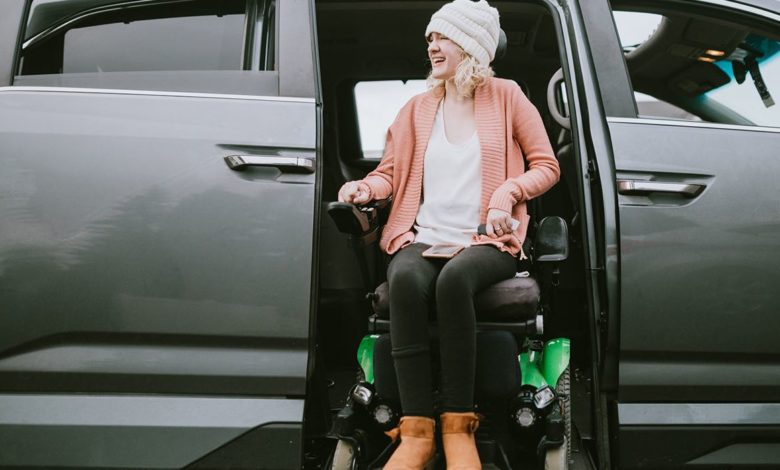
Daniel Davies is determined to keep accessibility for disabled passengers front and center as the autonomous vehicle (AV) industry races forward. His oldest brother John, who lives with severe intellectual disability and several physical disabilities, is depending on Davies’ focus.
Davies, founder and president of AbleLink Smart Living Technologies company in Colorado Springs, Colo, has developed WayFinder, which is designed to help people with cognitive disabilities and others with special needs navigate to their destination when using the mobile app features.
AbleLink was one of 10 semi finalists in the Inclusive Design Challenge contest launched last year by the U.S. Department of Transportation (DOT) to spur innovation in bringing accessibility features to autonomous vehicles. A final winner is expected to be selected next summer, and $5 million in cash prizes given out.
As the industry races ahead to develop fully autonomous vehicles that can drive anywhere and under the conditions without a human driver, it also seeks to ensure disabled passengers aren’t left behind. And the AV industry also needs IT professionals with certain skill sets and experience levels to take the wheel on this effort.
Autonomous Vehicle Industry Races Ahead
Autonomous vehicles are rapidly emerging across city streets and highways, with more than 33 million AVs expected to be sold by 2040, according to IHS Markit. Disabled passengers are a segment of the population who are expected to greatly benefit from autonomous vehicles, say representatives of disability organizations.
“We are extremely excited for AVs, since it can open the doors for people who can’t drive,” said Claire Stanley, a public policy analyst with the National Disability Rights Network. “I’m blind and the idea of AVs is extremely exciting. But if you don’t develop the technology with accessibility in mind, you may miss serving our community. We want to make sure we aren’t left behind.”
Currently, there are 61 million adults in the United States with a disability, representing approximately 26% of the population, according to the Centers for Disease Control and Prevention. And of those who have a disability, an estimated 25.5 million Americans experience a travel-limiting disability, according to the U.S. Department of Transportation (DOT).
AVs are expected to be predominately used as a transportation service, similar to taxis and buses, and are largely restricted to certain areas of operation and under certain weather and time-of-day operating conditions. But the AV industry is striving to develop vehicles that will drive on any terrain and under any conditions without a driver behind the wheel, and is looking to also expand the industry’s sales beyond transportation services to consumers.
Driving Accessibility into AV technology
“In 2015, we completed the world’s first fully autonomous ride on public roads in Austin, Texas, with friend of the project, Steve Mahan, who is visually impaired. This was the first time riding in a vehicle by himself, and showed the true potential autonomous driving technology holds for people with disabilities,” a Waymo spokesperson said. Waymo, based in Mountain View, Calif., is a semi-finalist in the DOT’s Inclusive Design Challenge.
Four key areas need to be addressed when designing AVs for disabled passengers, said Stanley, whose organization has a seat at the table with major automakers, from GM to Ford, as part of AV accessibility discussions. They include:
- Human-friendly interface. When designing an app to contact an AV service, take into account that a blind person and also someone who does not have use of their hands may need a voice-activated touch screen.
- Design multimodal AV features. Even though some people may have the same disability, their needs may vary. An individual who is deaf may prefer sign language over written text in certain situations, while another person who is hearing impaired may prefer large text.
- Create ways to interact with the AV upon approach. Incorporate a signal on the smartphone that notifies the passenger that they are getting closer to approaching the correct AV, such as a beep that speeds up.
- Automate the onboarding process. Individuals with physical disabilities may need automatic ramps or lifts to get into the vehicle, as well as ways to automatically secure their wheelchair once inside.
Waymo is working on such features as haptic vibrations, similar to a hot-cold approach, when a user gets closer to their AV taxi or shuttle, as well as exploring ways to use flashing lights to signal to users who have hearing disabilities, a Waymo spokesperson said.
AV Industry Needs These IT Professionals
“It’s not easy to find professionals with both the technical skillset and the human services perspective,” Davies said. “The best technologists in this area have a family member or a direct connection to someone who is disabled. They have a motivation that goes beyond working on a project, or building a widget, because they see beyond that to see the impact it can make on individuals’ lives.”
Indeed. Foresight Augmented Reality, based in Atlanta, was founded approximately three years ago out of a similar situation — a passion to help disabled users.
Chris Webb, co-founder and CTO of Foresight Augmented Reality, and David Furukawa, co-founder and CEO of Foresight, created the company after a tragedy.
Furukawa, who suffers from retinitis pigmentosa and is virtually blind, was walking across the street with his young son when a car hit Furukawa and his guide dog, which managed to push his son out of harm’s way. Furukawa survived the accident but his beloved dog did not.
“I was sitting in the hospital with David, who had a broken leg and a couple of other broken bones, and said, ‘let’s figure something out to help you understand the environment around you,” said Webb, who at the time was shifting his tech career out of telecom and looking to take on a different challenge.
Foresight, also a semi-finalist in the DOT’s Inclusive Design Challenge contest, is developing an accessible app with an agnostic interface that uses ultra-wideband (UWB) technology to help visually impaired and blind users navigate to their desired locations with greater accuracy than using GPS.
Webb noted there are more challenges to developing technologies for disabled users than for the broader population at large.
Human factors engineering, working with people who have physical and, or, cognitive disabilities, and most importantly a desire to help disabled users are all important traits needed to work in the AV industry. But in addition to those traits, these technical skills are in high demand for autonomous vehicle positions.
Software engineer, C++ developer, R&D engineer, senior software engineer and systems test engineer, product manager, deep learning engineer and system engineer ranked among the most in-demand job titles for AV jobs listed over a 12-month period ending in June, based on Indeed.com’s job postings, according to data provided to IEEE-USA InSight by Indeed.com.
Silicon Valley captured the highest percentage of AV job postings across the nation during this year-long period with 18.6%, followed by the greater San Francisco Area with 11.5%, according to Indeed.com. The greater Detroit area captured 6.4% of the AV job postings, while Pittsburgh landed 6%, and the greater Boston area 5.3%.
“Too often people with disabilities are not considered upfront and are more of an afterthought as new technologies are developed. Autonomous vehicle technology can be really life-changing for people with disabilities,” Davies said, adding, “Transportation is one of the important aspects of life for people with disabilities. It helps you get to work, have a job, lead an enriched life and participate in the community. Without transportation, you don’t have freedom.”



